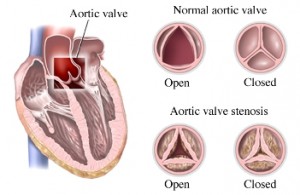Aortic stenosis is narrowing of the aortic valve, impeding delivery of blood from the heart to the body. When the degree of narrowing becomes significant enough to impede the flow of blood from the left ventricle to the arteries, heart problems develop.

Causes of Aortic Stenosis
In adults, three conditions are known to cause aortic stenosis: progressive wear and tear of a bicuspid valve present since birth (congenital), wear and tear of the aortic valve in the elderly, and scarring of the aortic valve due to rheumatic fever as a child or young adult. Bicuspid aortic valve is the most common cause of aortic stenosis in patients under age 65.
Symptoms
The major symptoms are: chest pain (angina), fainting (syncope), and shortness of breath (due to heart failure). In a low percentage of the patients with aortic stenosis, the first symptom is sudden death, usually during strenuous exertion. Chest pain is the first symptom in one-third of patients and eventually occurs in one-half of patients with aortic stenosis. Fainting (syncope) related to aortic stenosis is usually associated with exertion or excitement. Initially, shortness of breath occurs only during activity. As the disease progresses, shortness of breath occurs at rest.
Treatments
Echocardiogram and cardiac catheterization are important tests in diagnosing and evaluating severity of aortic stenosis. Patients with aortic stenosis who have symptoms may require surgical heart valve replacement. Patients with aortic stenosis are usually given antibiotics prior to any procedures which might introduce bacteria into the bloodstream, such as dental procedures and surgeries.
Dr. Ciuffo and the Minimally Invasive and Bloodless Heart Surgery Program
Dr. Ciuffo is dedicated to helping you understand and treat your heart problemsIf you have any questions about this disease or the steps we will take to treat it, feel free to contact us at (330) 588-4676 or visit our contact page online.

